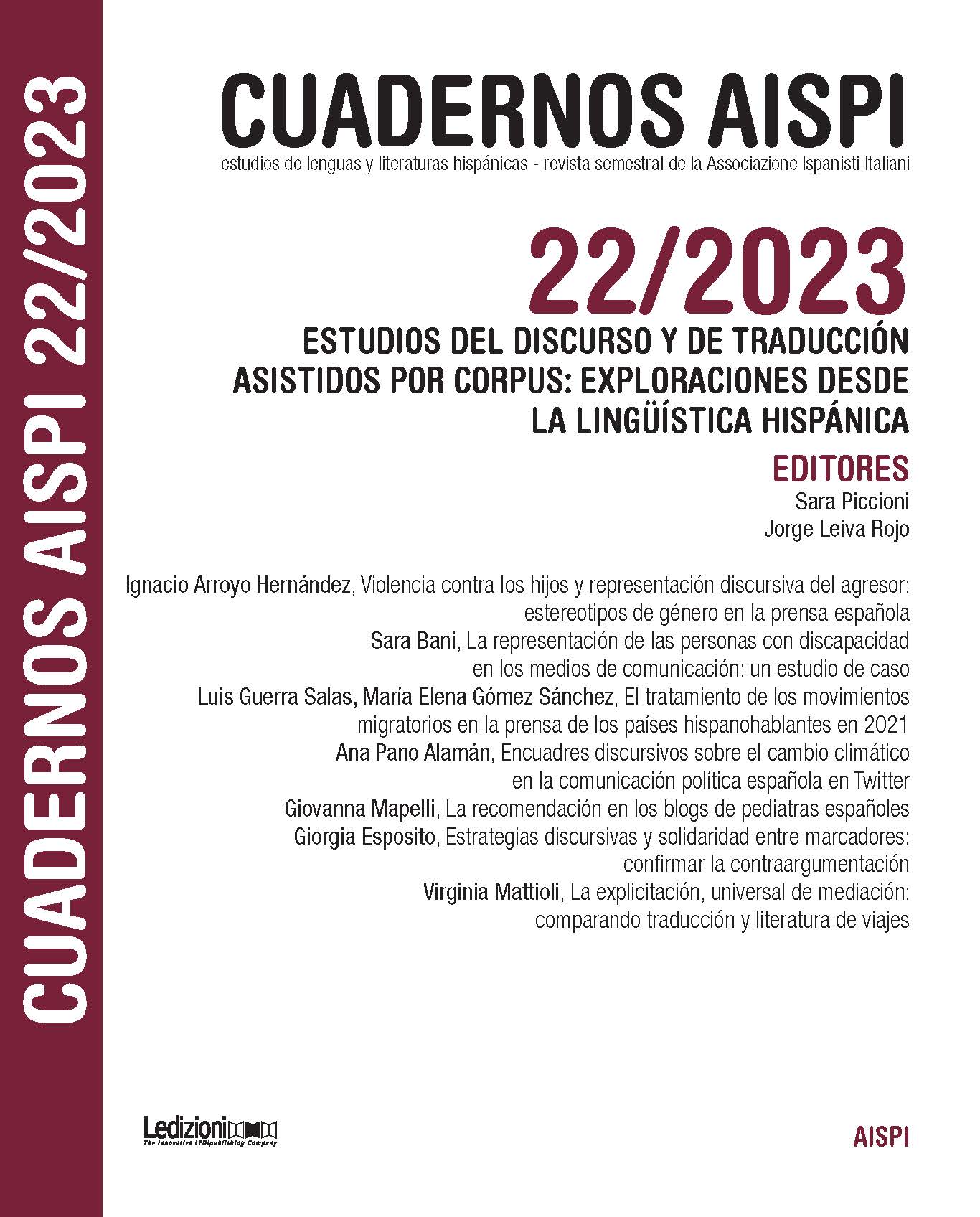Violence against children and discursive representation of the aggressor: gender stereotypes in the Spanish press
DOI:
https://doi.org/10.14672/2.2023.2305Keywords:
critical discourse analysis, agentivity, crime, stereotypes, genderAbstract
The study applies Critical Discourse Analysis to examine the discursive representation of filicide in the Spanish press. Through a quantitative analysis of two news corpuses, which pays special attention to agentivity, it is verified whether the gender of the aggressor is a significant variable in the treatment of crimes and whether the approach adopted by the authors of the texts reproduces gender stereotypes.
Downloads
References
Barnett, Barbara (2006), “Medea in the media: Narrative and myth in newspaper coverage of women who kill their children”, Journalism, 7/4: 411-32.
Barón Picazo, Irene; Carrasco Sánchez, Nerea; Santos Hermoso, Jorge; López Ossorio, Juan José; González Álvarez, José Luis (2021), “El filicidio en España: Situación y limitaciones para su estudio”, Behavior & Law Journal, 7(1): 13-22.
Barroso, José Luis Buenestado (2011), Derecho Penal Parte Especial y las consecuencias jurídicas del delito en España, Madrid, Bubok.
Coughlin, Anne M. (1994), “Excusing Women”, California Law Review, 82/1: 1-93.
Company, Alba; Pajón, Laura; Romo, Julieta; Soria, Miguel Ángel (2015), “Filicidio, infanticidio y neonaticidio: estudio descriptivo de la situación en España entre los años 2000-2010”, Revista Criminalidad, 57/3: 91-102.
Debowska, Agata; Boduszek, Daniel; Dhingra, Katie (2015), “Victim, perpetrator, and offense characteristics in filicide and filicide-suicide”, Aggression and Violent Behavior, 21: 113-24.
Fairclough, Norman (1989), Language and Power, London/ New York, Routledge.
Fairclough, Norman (1995), Critical Discourse Analysis: The Critical Study of Language, London, Routledge.
Gruber, Aya (2013), “Neofeminism”, Houston Law Review, 50/5: 331-44.
Gulim, Tussupkhanova (2012), Construction of Female Criminals in Criminology (Russia and Kazakhstan), MA Thesis, University of Budapest.
Jones, Stephen (2008), “Partners in crime: A study of the relationship between female offenders and their co-defendants”, Criminology & Criminal Justice, 8/2: 147-64.
López García, Fernando (2018), Inacusatividad, agentividad y causatividad: propuesta de un paradigma causativo para el español, tesis doctoral, Universidad Complutense de Madrid.
Lorente Acosta, Miguel (2021), “Violencia de género y comunicación social de los medios”, El poder de la comunicación. Claves de la comunicación estratégica en los espacios jurídico y político, eds. Sara Muñoz González; Belén Iboleón Salmerón; Nieves Ortega
Pérez; Luis Ángel Triguero Martínez; Selina Serrano Escribano. Madrid, Dykinson: 241-49.
Morrissey, Belinda (2003), When Women Kill: Questions of Agency and Subjectivity, London, Routledge.
Naffine, Ngaire (1987), Female Crime: The Construction of Women in Criminology, Sydney, Allen & Unwin.
Núñez Ladeveze, Luis (1991), Manual para periodismo, Barcelona, Ariel.
Pérez Montero, Roberto C. (2022), La regulación de los delitos de homicidio y asesinato tras la reforma operada por la ley orgánica 1/2015, TFG, Universidad de Cádiz.
Perri, Franck, S.; Lichtenwald, Terrance G. (2010), “Last Frontier: Myths & the Female Psychopathic Killer”, The Forensic Examiner, 19/2: 50-67.
Reynolds. Tania; Howard, Chuck; Sjåstadd, Hallgeir; Okimoto, Tyler; Zhu, Luke; Baumeisterf, Roy F.; Aquino, Karl; Kim, JongHan (2020), “Man up and take it: Gender bias in moral typecasting”, Organizational Behavior and Human Decision Processes, 161:120-41.
Seal, Lizzie (2010), Women, Murder and Femininity: Gender Representations of Women Who Kill, Basingstoke, Palgrave Macmillan.
Theiner, Irene M. (2012), “La función argumentativa de la descriptivización en el discurso periodístico”, Testi e Linguaggi¸ 6: 269-91.
Vaccaro, Susanna (2021), Violencia vicaria: un golpe irreversible contra las madres. Estudio sobre el análisis de datos de casos de violencia vicaria extrema, Junta de Andalucía [20/12/2022] <https://observatorioviolencia.org/wp-content/uploads/AMPFInforme_
V_Vicaria-digital. Pdf>
Van Dijk, Teun A. (1996), La noticia como discurso, Barcelona, Paidós.
Van Dijk, Teun A. (2004), “Discurso y dominación”, Grandes Conferencias en la Facultad de Ciencias Humanas, 4, Bogotá, Universidad Nacional de Colombia: 5-28.
Van Dijk, Teun A. (2005), “Contextual knowledge management in discourse production: A CDA perspective”, A new agenda in (critical) discourse analysis: Theory, methodology and interdisciplinarity, eds. Ruth Wodak; Paul Chilton. Amsterdam, John Benjamins: 71-100.
Van Dijk, Teun A. (2010), “Discurso, conocimiento, poder y política. Hacia un análisis crítico epistémico del discurso”, Revista de investigación lingüística, 13: 167-215.
Van Dijk, Teun A. (2016), “Estudios Críticos del Discurso: Un enfoque sociocognitivo”, Discurso & Sociedad, 10/1: 137-62.
Volkova, Tatiana N. (2001), Kriminologicheskie i pravovye problemy zhenskoi prestupnosti v sovremennoi Rossii, Criminological and legal problems of female criminality in Russia today, tesis doctoral, Universidad de Ryazan.
Wodak, Ruth; Meyer, Michael eds. (2009), Methods of critical discourse analysis, London, SAGE.
Downloads
Published
Issue
Section
License

This work is licensed under a Creative Commons Attribution-NonCommercial-NoDerivatives 4.0 International License.
La revista está publicada bajo la licencia Creative Commons CC-BY.




